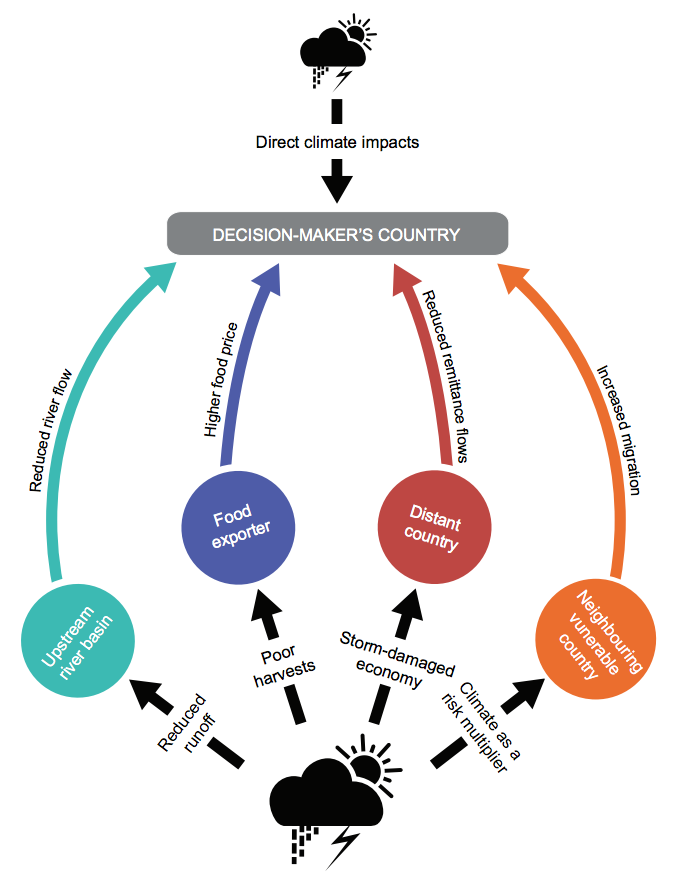National Adaptation Plans and the indirect impacts of climate change

Introduction
Climate change poses substantial challenges to development around the world, particularly for poorer countries, which means effective adaptation is essential. Many governments are currently drafting variations of National Adaptation Plans (NAP) under the United Nations Framework Convention on Climate Change (UNFCCC), which creates an opportunity to raise the ambition and coherence of adaptation planning to new levels.
Adaptation planning to date has tended to focus locally, reflecting the local jurisdiction of most decision-makers, and the direct nature of many climate impacts. Yet societies and economies do not exist in isolation; through global trade, financial ties and migration, we are highly interconnected. In the context of adaptation, this means that both the climate risks we face, and measures to address them, extend well past territorial boundaries.
This policy brief* aims to help countries to take stock of what we call the “indirect impacts” of climate change – impacts that require adaptation in one place as the result of climate change somewhere else – and to address them in their NAP. This approach is in line with the UNFCCC’s NAP guidance, which urges countries to “develop strong working linkages between global, regional and national levels to ensure synergy and coherence of actions”.
Few countries have to date taken deliberate account of indirect climate impacts, focusing instead on direct impacts from climate change within their territories. Our focus here is on practical steps that planners can take to identify key indirect impacts and begin incorporating measures to address them in their NAPs.
*download from right-hand column or via link provided under further resources
Key points
-
Climate change impacts can extend beyond the places where they occur, indirectly affecting other countries through shared natural resources, global supply chains and trade, and the flow of people and finance around the world.
-
In crafting their countries’ National Adaptation Plans (NAPs), decision-makers should thus consider not only direct impacts, but also indirect ones. A simple framework described in this policy brief can help them identify and explore key indirect impacts, which can be incorporated into NAPs using existing frameworks.
-
Identifying and addressing indirect impacts will help countries to improve the effectiveness of their adaptation plans, uncover specific opportunities for synthesis with other countries, improve regional cooperation, and highlight how adaptation at the national level can improve overall regional and global resilience.
Policy recommendations
-
All countries should dedicate a section or chapter of their first NAP to the international and transboundary dimensions of their climate vulnerability and adaptation. This chapter should have at least two aims: 1) to identify specific indirect impacts which may be of concern for the country; and 2) to highlight how climate change in the country may create indirect impacts for others, including neighbouring countries, trade partners, and others.
-
NAPs should provide an overview of the opportunities and channels for cooperation at the regional and international level to address shared risks and indirect impacts through adaptation.
-
NAP coordinators should seek to engage and appoint to NAP Steering Groups new stakeholders internally, such as trade experts and departments; regionally, including fellow NAP coordinators in neighbouring countries and from regional economic organizations; and internationally, including via multilateral forums, in order to facilitate knowledge exchange, identify synergies and address shared climate risks identified in NAPs.
-
Draft NAPs should be shared between neighbouring countries early in their development to facilitate learning about vulnerability, impacts and adaptation issues that may have indirect (e.g. transboundary) effects and to identify gaps and shared responsibilities.
-
Monitoring and evaluation frameworks within NAPs should explicitly aim to track the development of rel- evant climate risks in neighbouring countries, as well as progress by neighbours in implementing adaptation to those impacts, in order to consider the implications for national planning.
-
Assessments of indirect impacts, for example those af- fecting international supply chains, could be referenced when appealing or applying for climate finance from bilateral and multilateral sources in order to emphasise the benefits of improved resilience internationally from adaptation at the national or sub-national level.
-
The role of the Global Adaptation Network and regional adaptation networks should evolve to explicitly identify and address shared climate risks and transboundary adaptation solutions.
-
The Adaptation Committee and the Least Developed Country Expert Group (LEG), supported by the United Nations Development Programme (UNDP) NAP Global Support Programme, should provide advice or guidelines to Parties on how to assess indirect impacts and the po- tential for coordination between NAPs to address shared risks via adaptation.
-
Future versions of the UNDP Adaptation Gap Report should assess the sum of national adaptation measures in NAPs to identify the adaptation gap in relation to indi- rect impacts and shared climate risks across borders.
Senegal Films – Adaptation without Borders
See the Senegal Films for an exploration of indirect impacts from the perspective of Senegal, focusing on rice import dependence as a climate risk, and the Government of Senegal’s ambitious response.
Access the policy brief here:
Further reading:

Comments
There is no contentYou must be logged in to reply.